JANUARY 8, 2011 — South of Alleppey, India, in a tiny town in the Kerala Backwaters called Amritapuri, sits a pink ashram run by Mata Amritanandamayi Devi, one of India’s few female gurus. Known as “Amma” (which means “mother”), she doesn’t prescribe any specific religious doctrine — unless, of course, you consider hugging to be a religion. Amma strives to better the world with unending, unconditional love, dispensed to her followers through marathon, 22-hour hugging sessions. “My religion is love. An unbroken stream of love flows from Amma to all beings in the universe,” she tells followers. “This is Amma’s inborn nature… To lovingly caress people, to console and wipe their tears until the end of this mortal frame — this is Amma’s wish.”
22-hour hugging sessions? I wonder if she rides around on unicorns and fights wars with Care Bears, I think to myself one night in an Indian guesthouse while researching her in the New York Times. But when I read that Amma’s devotees swear by the life-changing and healing power of her hugs, I grow curious: if I set my cynicism aside, might a blast of unconditional love in the form of a hug from Amma fix some of my life’s problems?
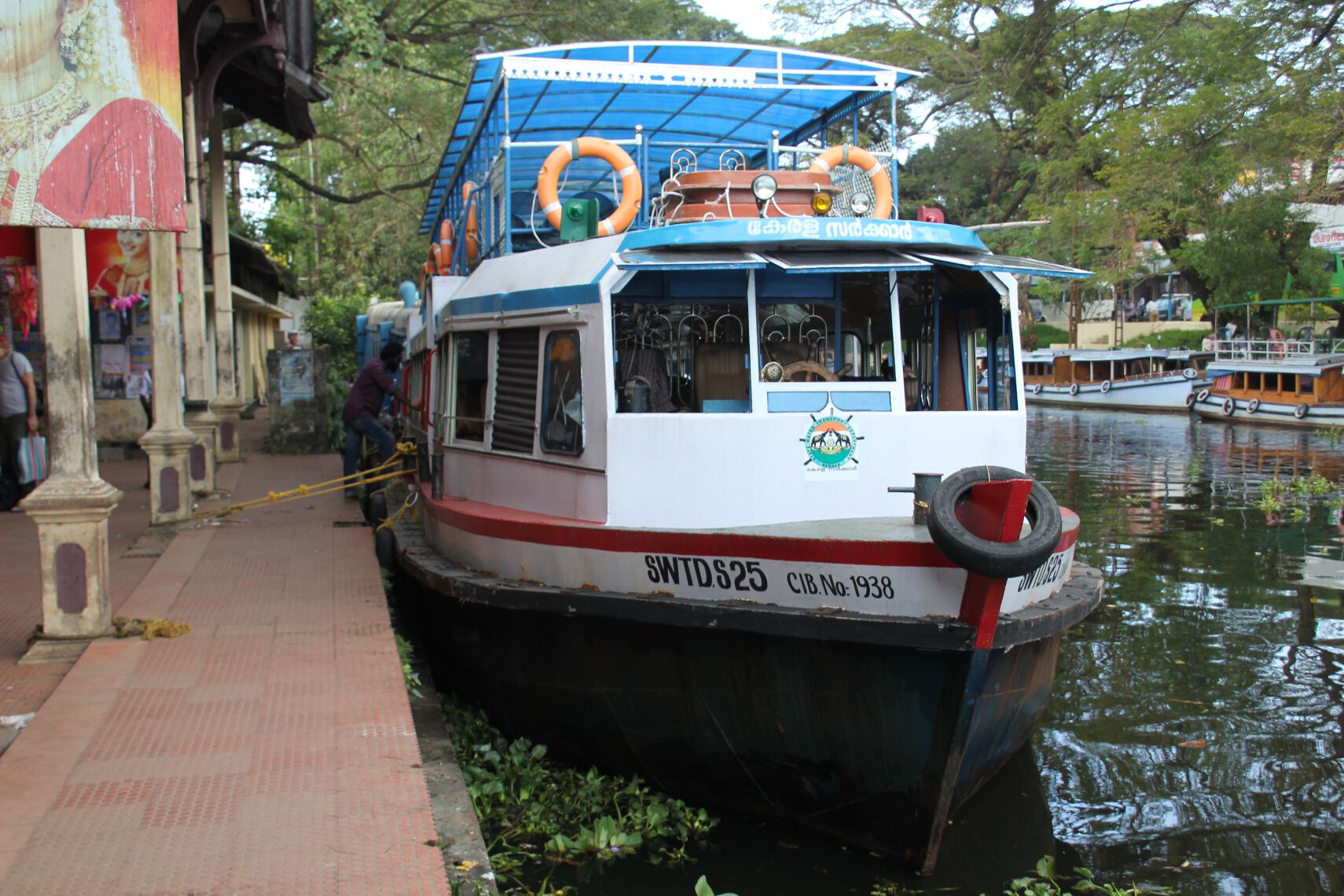
A ferry sits ready to take passengers from Alappuzha to Kollam in southern India.
I decide that I don’t want to miss my chance to find out. The next morning, I board Alleppey’s southbound tourist ferry and, at my request, the captain agrees to make a special stop at the Amritapuri dock. On the boat, I meet a group of Australian teenagers — Nick, Kate, Cassie, and Mindy — who have made a special trip to Southern India to visit Amma.
“Aren’t you excited?! She’s going to be at the ashram when we get there!” Mindy bubbles. She explains to me that she has called the ashram in advance to be sure that Amma, who spends much of the year traveling to her network of other ashrams around the world and raising money, will be present when we arrive.
“It never occurred to me that she wouldn’t be there,” I answer. Mindy and the other Australians eye me suspiciously. They already know that I’m a pretender.
When we arrive at the ashram, the five of us walk over a pink bridge and through a large gate, into a sea of people wearing white robes. Mindy tells me that Amma’s followers wear the robes to show their devotion to Amma, who chose at an early age to wear only plain white clothes as a statement of humility in juxtaposition to the brightly colored saris traditionally worn by Indian women. We make our way into the ashram’s temple, where I see devotees praying next to a huge, Jesus-like photograph of Amma, in front of a statue of Kali, the same idol for which I saw tens of chickens and goats sacrificed in Nepal a week earlier. I don’t see any goats or chickens here.
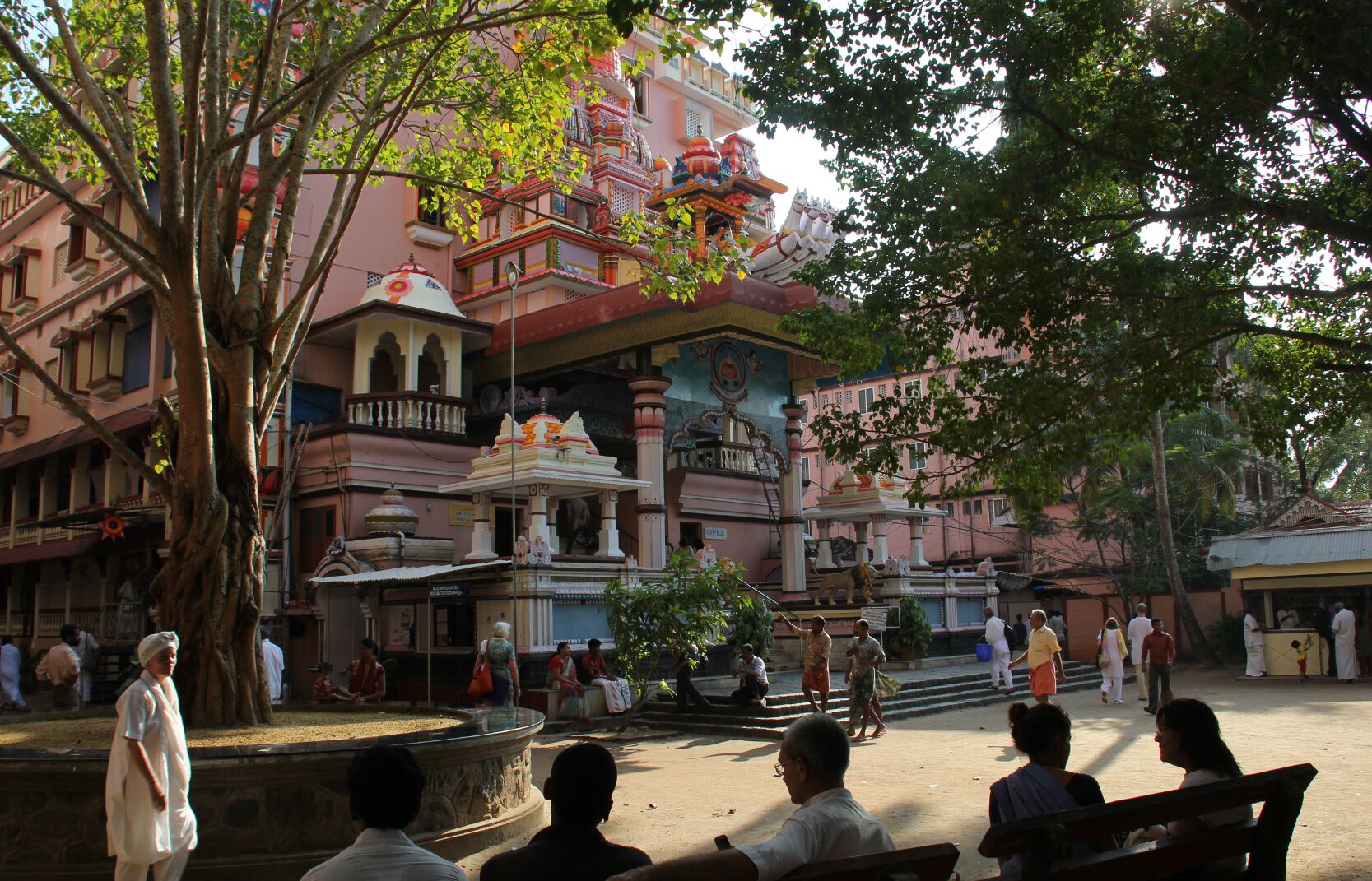
Devotees sit outside the ashram’s temple in Amritapuri, India.
Inside the temple, near a bulletin board with another photo of Amma and signs advertising meditation courses and begging ashram residents to do “Seva” (selfless chores), we find the foreigners’ check-in desk, where a man in a white robe gives me a registration form and takes my passport. In addition to my first and last name, the form also asks for my “Spiritual Name.” I reluctantly leave the space blank, worrying that by doing so, I am acknowledging an appalling void in my soul. I read a list of “Rules for Visitors,” which explains that in return for dressing modestly, not smoking, and 150 Rs (US $3.30) per day, I will receive dormitory accommodations, three Indian meals, and safe drinking water. When I return the registration form, the man in the robe tells me that I’ll only get my passport back when I check out of the ashram. They’re never going to let me leave, I worry.
The ashram grounds are so large that I become hopelessly lost on the way to my room, but I run into a 24-year-old Canadian named Mike with a decidedly vacant look in his eyes who offers to help me. On the way, he tells me that he has been living in the ashram for a year, which seems, to me, like a very long time to live in an ashram.
“I was just traveling around India, and when I came to visit, I never wanted to leave,” he tells me. Oh my God, I really am going to be brainwashed and live here for the rest of my life, I think.
“Amma is just amazing,” he goes on, starry-eyed. “I’ve never met anyone like her.”
I settle into my bunk bed in a room with six other guys, including Australian Nick and an Israeli named Ori who has spent two months in the ashram. It’s almost 100F degrees, and I half-jokingly tell Ori that I’m dying for a milkshake. To my surprise, he tells me that the ashram has a “Juice Stall” which serves them. We head over. In addition to yet another photo of Amma — who I’m starting to realize may be one of the world’s most shameless self-promoters — posters on the “Juice Stall” door instruct customers to follow a set of bewildering rules to get juice: “Please follow ‘Q’ System,” “Collect your token and get juice,” “Juice Stall Timings: 10:30 AM to 12:30 PM/4:00 PM to 6:00 PM/8:00 PM to 9:30 PM/Tuesday 3:00 AM to 6:00 PM,” and, “This is a strict order! Students are hereby requested to bring their own cup or glass to buy milk.” Despite stern looks from the Juice Stall workers, I manage to get a cup, stand in line, collect a token, and order two milkshakes (it’s really hot), but the process feels like trying to get a milkshake in Communist Russia.
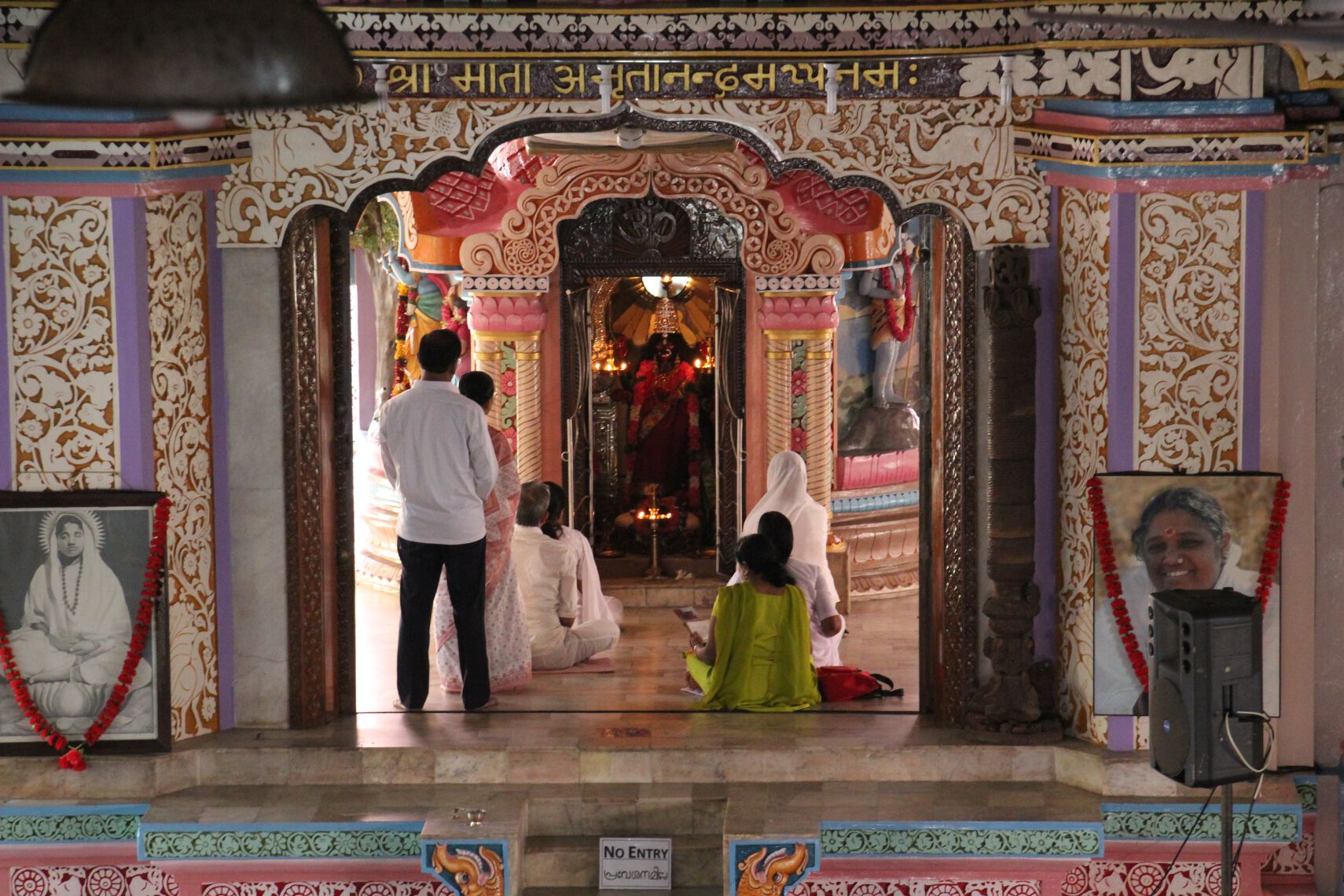
Amma followers worship in front of a statue of Kali in the temple at Amritapuri next to a large photograph of Amma.
As we enjoy our milkshakes, Ori tells me that he does “Seva” chores every day, ranging from manning the Juice Stall to sorting recyclables to “compost duty,” which, he tells me in his Israeli accent, is “really just swimming in shit.”
“But,” he explains, “the people willing to do compost duty are unique. You meet some really cool people swimming in shit. And it’s all for Amma.”
Afterward, I return to the temple for a scheduled tour of the ashram with other new arrivals and meet a tour guide, a California transplant who tells us that her name is Naranuna (almost certainly her “spiritual name”). She apologizes for not removing her sunglasses (“My recent ayurvedic eye treatment has been very painful,” she explains) and seats us in front of a television to watch a clumsily-produced propaganda video all about the greatness of Amma. The video spends 30 minutes Jesusifying Amma, claiming that Amma has hugged 26 million people in her lifetime and that her charity organization, Embracing the World, has contributed an impressive US $46 million to 2004 Asian Tsunami victims and US $1 million to victims of Hurricane Katrina. Most interestingly, the video hints strongly at the transformative power of Amma’s hugs, as hug recipients are seen crying, fainting, and generally freaking out. By the time the video is over, even Naranuna is teary-eyed and can barely get a coherent sentence out: “Isn’t Amma absolutely amazing!?” she gushes.
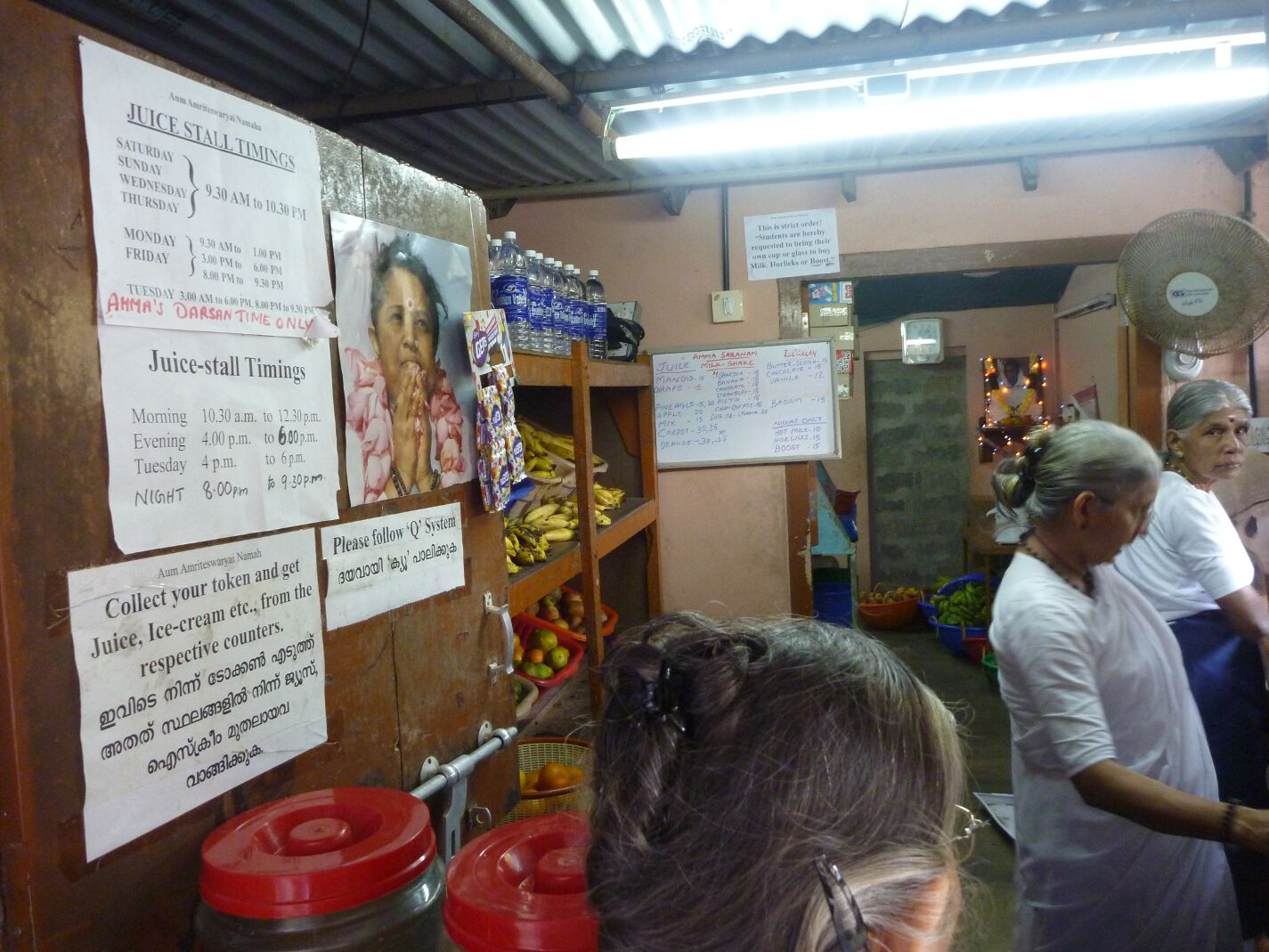
The Amritapuri juice stall has a complex set of rules for its customers.
I start to wonder whether my family is going to need to hire Harvey Keitel to deprogram me (and Naranuna). (See: Holy Smoke.)
When Naranuna asks if the group has any questions, I ask her as politely as possible whether people perform Hindu animal sacrifices to Kali at the ashram.
“Amma doesn’t teach any specific religion, and she thinks of Kali’s bloodlust as a metaphor for the strength necessary inside everyone to fight evil, not as a real craving that needs to be fed with sacrifices,” she responds. I’m impressed by her sensible answer. I also find it refreshing that Amma isn’t trying to convince people of the validity of a specific God or martyr. I start to realize that, maybe, evangelizing unconditional love and hugging is somehow less ridiculous than proselytizing more traditional religious beliefs.
Afterward, Naranuna takes us on a tour of the ashram grounds and shows us Amma’s childhood home and an adjacent cowshed. She tells us that Amma’s family asked her as a teenager to dispense her hugs from the cowshed so that their home wouldn’t be constantly filled with hug-seeking visitors. At the end of the tour, Naranuna tells us that we’ll need to get a numbered token the following morning to get “Darshan.” In Amma’s case, “receiving Darshan,” the Sanskrit word for seeing a guru, is synonymous with getting a hug from her. Because so many people want an Amma hug, the process is managed with numbered tokens.
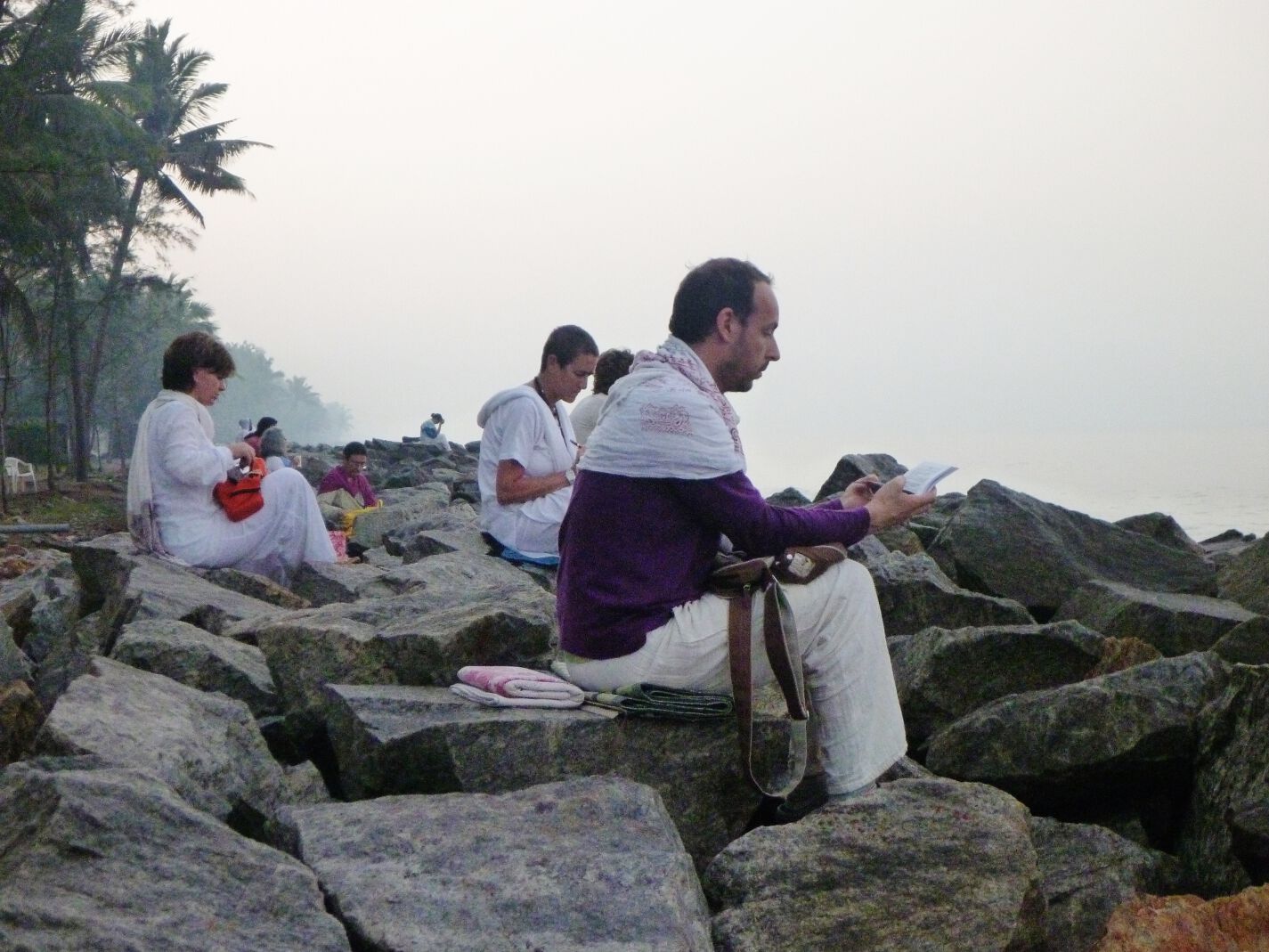
Devotees meditate on a beach in Amritapuri, India.
“Many people want to say something to Amma or ask a question when they get Darshan, so think about what you might want to say,” Naranuna explains. A question? What kind of question should I ask Amma?! I wonder to myself.
After the tour, I spend an hour singing mantras (known as Bhajans) with Amma and her devotees (“It’s a very special treat,” Naranuna told us) and frantically running through question ideas for Amma in my head: “Which came first: the chicken or the egg?” “Why is buying a milkshake in the ashram so complicated?” “What will next week’s winning lottery numbers be?” “Will I ever see Sophie, the blond, French girl from the Taj Mahal ever again?”
Afterward, while I’m standing in line for a curried rice and potatoes dinner ration, I meet Ana, a 22-year-old girl from Sweden who has been living at the ashram for six months, doing volunteer work for Amma’s Habitat-for-Humanity-like home-building charity. Ana is charming and seems surprisingly well-adjusted. I eat dinner with her and two of her friends, both women in their sixties. One of them, another Swedish woman named Lalita (her spiritual name), tells me that she has been living in the ashram for 11 years, which seems, to me, like a very, very, very long time to live in an ashram.
“After I got divorced, I visited the Ashram,” Lalita tells me. “I got involved with Amma’s charity work and I never left. Amma is wonderful. Once you get your first hug from Amma, you’ll stay too.” She seems sure. Amma must supplement these hugs with a brainwashing drug, I think. Or, maybe, limitless, unconditional love is powerful enough.
At 4:50 AM the next morning, I wake up in a pool of my own sweat, miserable from the humidity and the stench of five other guys sleeping on bunk beds in my room. There’s no hug in the world that could convince me to stay in a place this hot without air conditioning, I think. I walk to Amma’s cowshed to attend a morning puja, a religious ceremony in which water, flowers, incense, and food are offered to a Hindu god. The ceremony is interactive, so I awkwardly try to follow along as best I can: I wash my hands, eat a piece of unidentified fruit, and throw the flowers I’m given into the fire. I’m so hot that it’s hard for me to sense whether I’ve managed actually to summon a deity, but, during the ceremony, I’m hypnotized by the sound of women in the adjacent temple chanting mantras from the Bhagavad Gita, the sacred Hindu scripture. California feels very far away.
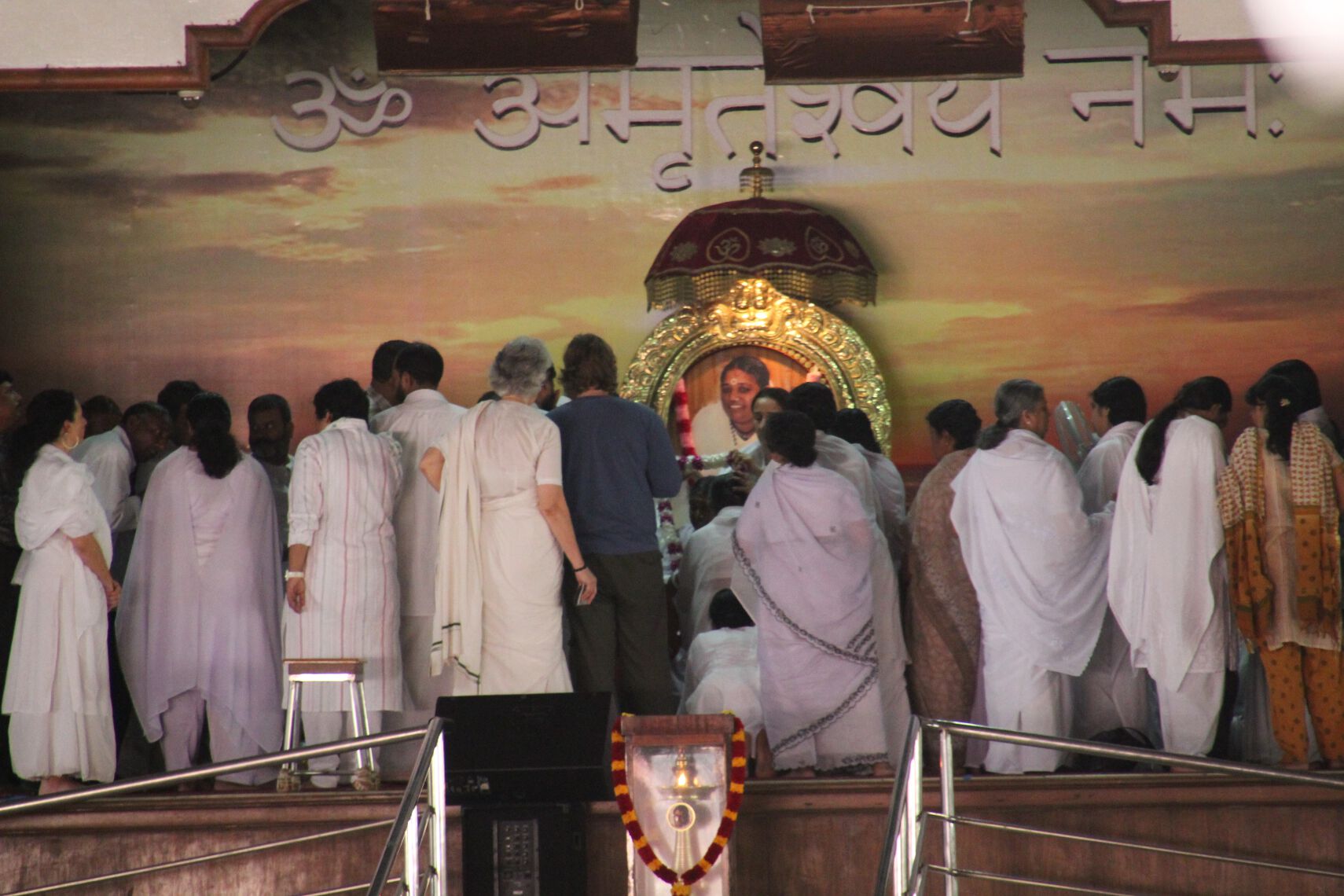
Amma hugs devotees in Amritapuri, India.
After the ceremony, I join a group of ashram residents on a nearby beach for the ashram’s daily three-hour meditation session, and then eat breakfast and retrieve my numbered Darshan Token. I’m assigned one of the first hugs of the day.
I meet up with the Australians from the boat, and they also have early Darshan numbers. After passing through metal detectors, we’re all ushered into seats on a stage where Amma is hugging devotees. I watch as Amma hugs person after person, for about 20 seconds at a time. Upon seeing Amma in person, one Indian woman bursts into tears. Another faints into the arms of her family. Some spend extra time with Amma after their hug, asking questions and discussing their life problems, mostly in Malayalam, the native language of Kerala. An emotional American woman waiting next to me says to her boyfriend, “There is so much energy on this stage I can barely hold myself together.” She fans herself with her hand, as though she might explode from hug-overload at any moment. I watch Australian Mindy get her hug, and her face looks flush. As she leaves, she whispers to me, “It was amazing.”
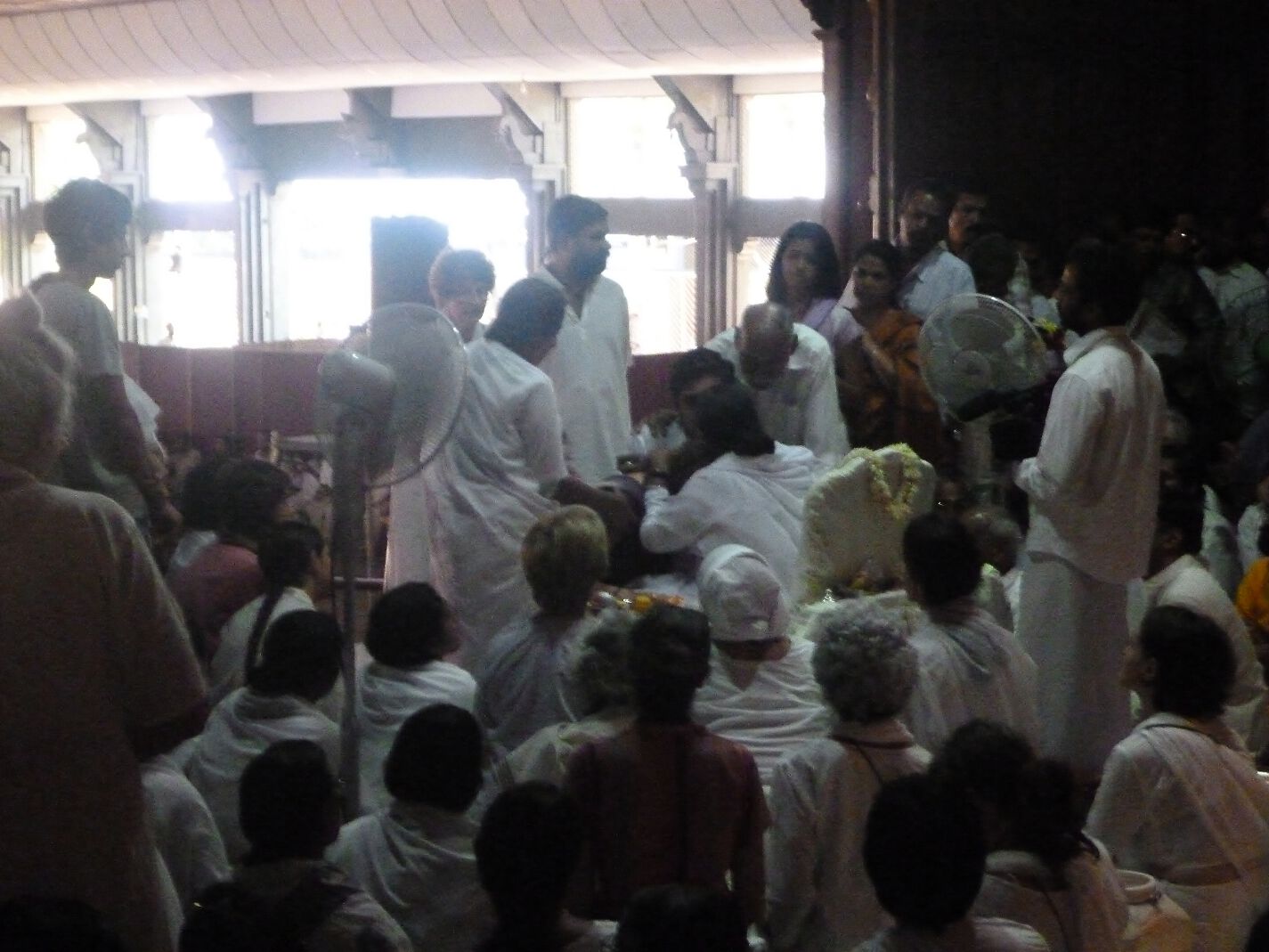
Amma hugs devotees in Amritapuri, India.
When it’s almost my turn, one of Amma’s white-robed devotees uses a towel to clean my face — apparently Amma doesn’t like face dirt or sweat — and then pushes me onto my knees. I kneel, inches from Amma, waiting for an Indian man to finish hugging her. When he finishes, two white-robed assistants immediately push me into Amma’s chest, carefully positioning my arms and hands on Amma’s body — maybe in an attempt to achieve the most powerful hug possible? As I’m hugging Amma, the Indian man who hugged her previously continues talking to her in Malayalam, in a very urgent tone, as though he’s trying desperately to confirm the launch codes for a nuclear submarine. My hug continues as they talk. After my hug has lasted about two minutes, I start to pull away, but Amma’s hug assistants forcefully hold me in place. I wonder if I will be stuck, hugging Amma, for the rest of my life. But, after a full four minutes, when the Indian man seems finally to have successfully confirmed his launch codes, my hug with Amma ends. I’m not that impressed. Aside from the fact that the hug seemed endless, it was a typical hug.
As I pull away, Amma’s and my eyes meet. I realize that this is my chance to ask her a question.
“Amma, how can I live a happy life?” I ask.
Amma, smiles, leans forward, and whispers into my right ear.
I can’t tell you what she said.
No, seriously. I can’t tell you because she whispered in Malayalam. I have no idea what she said.
But, as I walk off the stage, I notice that my mood has lifted.
I start to wonder if, maybe, by themselves, Amma’s hugs aren’t supposed to be life changing. Maybe they’re only symbols representing the secret to living a happy life: receiving and giving never-ending, unconditional love.
I wonder if that’s what Amma whispered in my ear.
How to Visit Amma’s Amritapuri Ashram
OVERVIEW: Mata Amritanandamayi Devi (“Amma”) is one of India’s few female gurus, and her ashram is located in Amritapuri in Southern India’s Kerala. Amma spends much of her time traveling around the world, so if you want to see her, be sure to call the ashram in advance to get her schedule. Of course, you can always visit the ashram whether she is there or not. If you can’t make it to India, Amma has other ashrams in locations around the world, including the US, Japan, Africa, and Australia.
LOGISTICS: Fly to Kerala’s Cochin International Airport (or, you can take a 22-hour train ride from Mumbai). Then, from the Eranakulam Junction train station, you can take a train (61 Rs/US $1.35) to Alleppey, the jumping-off point to the Backwaters. The Keralan government runs a tourist boat (300 Rs/US $7), which leaves at 10:30 AM from the Alleppey boat jetty and sails sightseers from Alleppey to Kollam. While the best way to see the Kerala Backwaters is on a canoe tour or houseboat, this ferry is still useful because, upon special request, the captain will drop passengers off at the Amritapuri dock (200 Rs/US $4). The full ferry tour to Kollam is a too-long eight hours on a principal waterway, but the five-hour trip to Amritapuri is bearable, and the boat stops for a 30-minute lunch (food cost not included). If you prefer, you can skip the ferry and take a train directly from Eranakulam Junction to Karunagapally (2.5 hours, 73 Rs), which is the closest station to Amritapuri.
VISITING THE ASHRAM: Visitors to Amritapuri may stay overnight at the ashram for 150 Rs (US $3.30), which includes a shared dorm room and three Indian meals. Western-style food is available for extra money. A typical day at the ashram starts at 5 AM with an hour-long puja ceremony or mantra chanting. Devotees spend the following three hours meditating; yoga, meditation, and other classes are often available during this time. Breakfast is served at 9 AM, where you can also get a Darshan token to get your hug from Amma. After breakfast, people perform their Seva (selfless chores). In the evening, singing Bhajans starts at 6 PM and is followed by dinner at 7 PM. Most devotees go to sleep soon after dinner — after all, the next day starts again at 5 AM. Keep in mind that Amritapuri is a very large and busy ashram, especially when Amma is there. Those looking for a small, peaceful, tightly-knit ashram may be disappointed.
i love this – so honest, and lovely photos. sometimes what changes our lives is our own perceptions. 🙂
I'm glad that you aren't still living in an ashram. I think 1 day is a long long time to live in an ashram. Even one that has milkshakes.
I returned to California last week from my 6 month stay at Amritapuri and LOVE what Hank Leukart has written about his experience there. He forgot to mention that at the juice stall a glass of freshly squeezed pineapple juice costs 20 rupies (45 rupies per $).
Rock salt crystals have the ability to draw negative energy… that's why they're used in bath water to relieve ache and pain=negativity. Maybe Amma's hugs work in the exact same way? She hugs you and draws all the negativity, mental and physical out of you. You feel lighter and better just like after a refreshing rock salt bath!
Hilarious
For some it comes quickly, for others it takes time. 3 years ago I met Amma and just last week in Barcelona my heart opened fully to unconditional love. She is delightful, funny and she helps an awful lot of people who need it. Can't wait to be with her again. Thanks for a great article.
Thank you – I was there for nearly 3 weeks. 2 weeks with Amma, 6 days without here, because she left for the North India Tour. I'm so impressed – looking forward to my next visit in Amritapuri.
Christmas and New Years Eve with Amma are very special experiences..
That was so enjoyable!.. so funny. I am thinking of visiting the ashram… if there are any more guys like you there I am sure it will be a great experience!
Spoken from an loving and open heart ,unconditionally ;), therefor touching people,maybe Amma told you stay true to yourself..you have an gift !
Nice article! Honest and open.
I just had a darshan of Amma earlier this week in San Ramon, CA. I did not channel any earth shattering message, except that just the act of hugging people non-stop without a break is itself an act of love and giving. If that inspires people to be more giving and loving, more power to Amma. Interestingly, my first impression of the San Ramon ashram was that I had wandered into one of the Indian temples with the usual chaotic stalls and people milling around. The cows, fresh flowers etc. were missing, but the food was great. The volunteers were all sweet and helpful.
Beyond hilarious !!! Amazing article and so honest.
Planning to visit the ashram next week with exactly the same doubts and questions you had !
Would love to read more of your articles. And all the very best 🙂
I love this. I’m on an 18hr train ride from Mysore to Kerala to visit Amritapuri at the moment and doing a little research. Thanks for sharing your experience with such humor and authenticity.